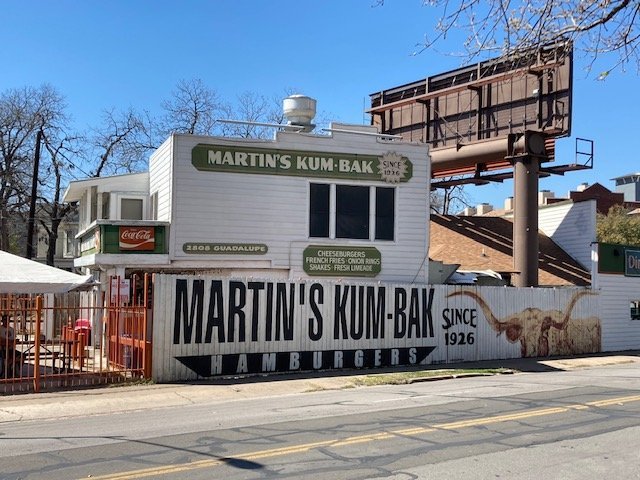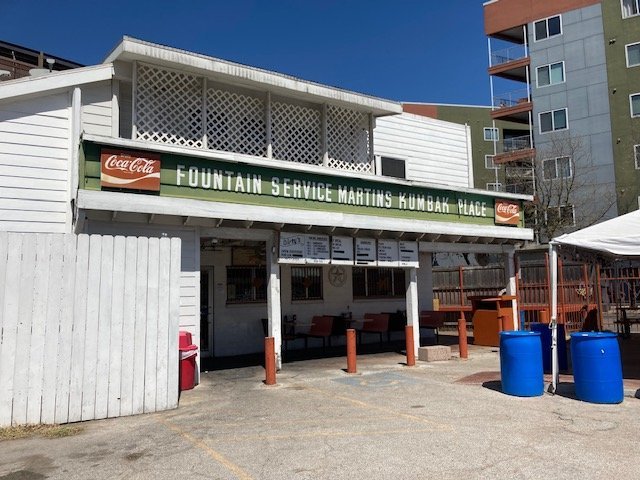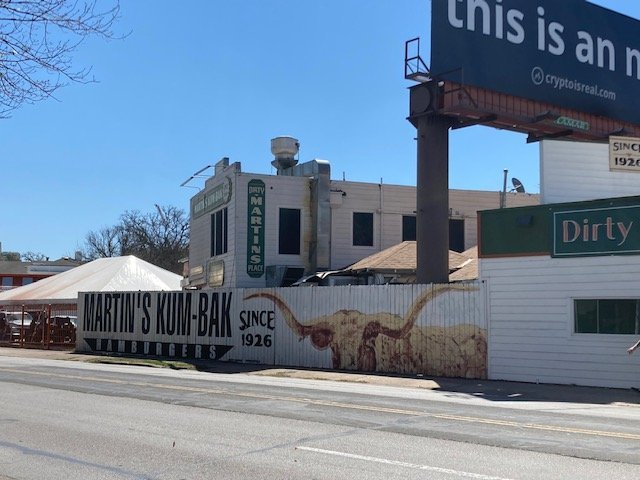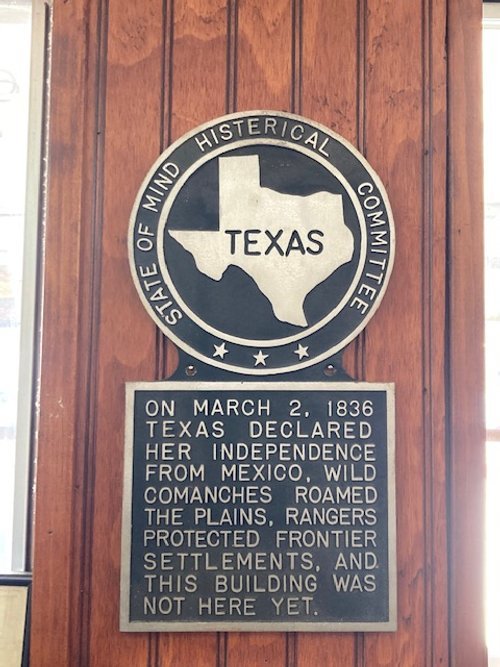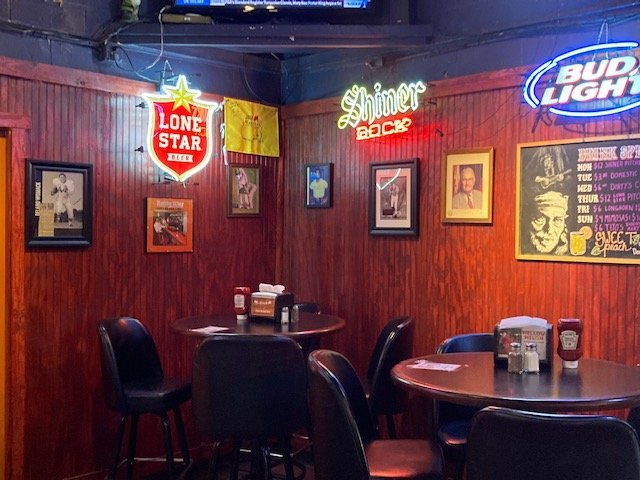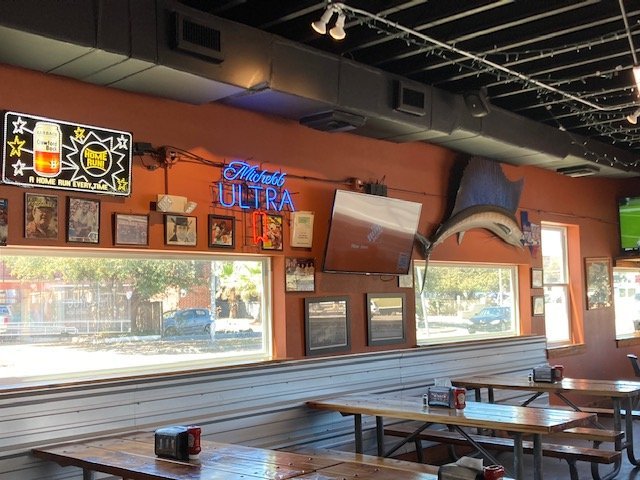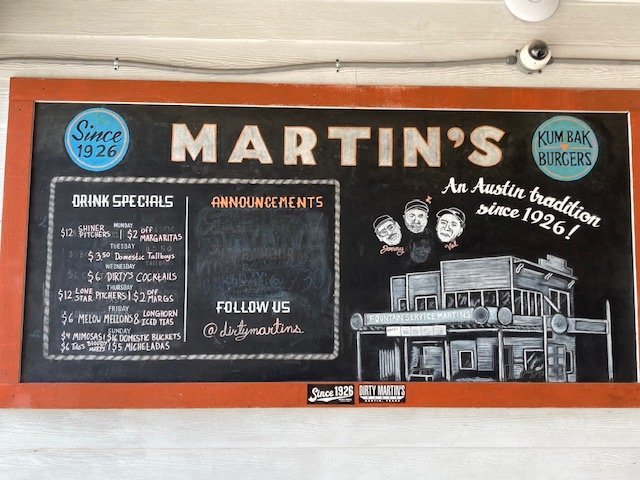Changing Days at Dirty Martins
BY MARY KAHLE, PRESERVATION AUSTIN POLICY INTERN, SPRING 2022
What makes a place special? Historic preservationists look at many factors when deciding what to save, from age and architecture to historical associations and community value. Others simply recall the taste of their favorite hamburger as they unwound with friends or gathered with family to cheer on the Burnt Orange. Still others recall cherished employees with decades of dedication. For Dirty Martin’s Place, a beloved hamburger joint and legacy business at 2808 Guadalupe Street, those memories are coming into sharp relief as Austin builds a new future with Project Connect.
Approved by voters in 2020 as Proposition A, Project Connect expands the city’s transit network with new light rail lines and rapid bus routes, a downtown transit tunnel, and other infrastructure improvements. Funds for anti-displacement strategies are also included in its scope. Community priorities under Project Connect include opportunity and equity, environment and sustainability, and innovation and technology.
Currently in the design phase, the Orange Line is the proposed north-south light rail route; it will ultimately stretch from north of Parmer Lane to just north of Slaughter Lane. This includes a portion that tracks Guadalupe by UT (“the Drag”) and heads north past Dirty’s, where a curve in Guadalupe complicates the rail’s straight trajectory. As proposed, the Orange Line’s path at the curve entails the demolition of Dirty’s and other nearby structures, as well as two buildings at the intersection of Guadalupe and Dean Keeton Street.
Buried under the design documents depicting the sleek tracks and glossy cars of the proposed Orange Line is the story of the Meridian Highway, which was created in the early twentieth century to support the new, automobile-related travel from Canada to Mexico. Entering Austin from the north along what is now North Lamar, it crossed east to Guadalupe near today’s Triangle and aligned with Congress Avenue at two intersections. It then traced South Congress Avenue toward San Marcos. The development of I-35 later absorbed the Meridian Highway, but some of the restaurants, hotels, and car-related businesses that arose and prospered with Americans’ growing love of car travel can still be found.
This includes Dirty Martin’s. Known in its early years as Martin’s Kum-Bak after owner John Martin, it opened for business in the 1920s at 2404 Guadalupe. A 1922 Austin Statesman ad says, “While out driving stop and get a GOOD COLD ROOT BEER, ‘That Sassafras Drink.’ Also those KUM-BAK HAMBURGERS.” A 1926 ad with Martin’s name and the name “Red” Byrd boasts, “5 Years in the Same Location. Oldest and Best on the Campus. Eat a KUM-BAK HAMBURGER and you will have no other.” Yet another ad touting “SANDWICHES All Toasted” still places Dirty’s at the 2404 address in 1927.
Sometime in that period, the Dirty’s that Austinites know today opened at the 2808 location. The carport, storage structure, and paved area had been there since 1920; these were followed in 1935 by first and second floor spaces, two canopies, a small deck, and more paved area. The back room was enclosed relatively recently. The Dirty’s website says, “The restaurant had humble beginnings with a single flat top grill, an eight-stool bar, and a small drive-through out front.” An early photo in the Austin Chronicle showing a horse-drawn wagon in front reflects functional, vernacular-style architecture with a little flare, a building ideally suited to be the hangout of choice for generations.
And the name? Depends who you talk to. The Dirty’s website says that “the original Martin's KumBak … had DIRT FLOORS! In the early 1950s, a concrete foundation was finally poured in, but the customers who were familiar with the dirt floors, affectionately began referring to the restaurant as Dirty's.” In a similar vein, a 1980 Ellie Rucker column (Rucker was a well-known Q&A columnist for the Austin American-Statesman) quotes manager Faye Braddock: “‘When Mr. Martin owned it back in the ‘30s, it had a dirty, wooden floor covered with sawdust. … Airmen from the base used to flock in there. They named it Dirty’s because of the floor.’” Adding to the confusion is a 1940 ad that makes no mention of “Dirty’s” at all, just “Martin’s Place.” The dilemma is captured in a Statesman article from 2021, when Dirty’s was inducted into the Austin360 Restaurant Hall of Fame: “The name mutated a few times, and KumBack even remains on the exterior. Is it Dirty’s? Dirty Martin’s? Martin’s KumBack?” Current owner Mark Nemir says, “‘We don’t even know the name of the place to be honest with you.’”
Clearly the floors only added to its charm, because Dirty’s grew in popularity over the years. Carhop L.J. “Doc” Mallard, who worked at Dirty’s from 1947 to 1993, recalled in the Statesman, “‘When I came, … [legendary UT quarterback] Bobby Layne was playing football here and he still comes back for a hamburger. They were 25 cents then and a bottle of Schlitz was 18 cents.’” Mallard also recalled Martin’s Model A Ford with a sign that said, ‘Who woulda thought it, hamburgers bought it.’”
Those were heady days. A Dirty Martin’s Facebook page post says, “The night before the [1953] Texas vs. Baylor football game, a few members of the Longhorn Band gathered at Dirty Martin's ... and began to play from the second floor. The crowd swelled, cheerleaders arrived, and an ‘instant rally’ paraded south on Guadalupe Street to the Governor's Mansion, there to pay a courtesy call on Governor - and UT alumnus - Allan Shivers. Shivers obliged with a rousing speech for the Longhorn fans. The next day, #3-ranked Baylor arrived in Austin and were upset by Texas, 21 - 20.”
Employees at Dirty’s are as legendary as its customer base. Braddock, whose extended family worked at Dirty’s, said in a 1980 John Kelso column: “‘I’ll tell you why people stay on here. … ‘It’s because of [Cecil Pickens, who bought it in 1954]. If you need a TV, Cecil will go and buy it for you and take a little out of each pay check, whatever you tell him you can afford. Same with cars, stoves, ice boxes.’” Cook Wesley Hughes worked at Dirty’s from 1956 to 2009, and legend has it that his brother and fellow employee J.T. created Austin’s first bacon cheeseburger. Writes Rucker, “That was the beginning of the O.T. Special – named for J.T., the cook, only somehow it got to be O.T.” This past year, the Dirty’s Facebook page celebrated Zarin “Z” Turner, an employee of twenty-one years, and Valentine Franco, writing, “Known in these parts as ‘Val’ or ‘El Gallo’, Val has been a cook at Dirty’s since 1999.”
These memories reflect changing modes of service. A circa 1960s photo on the Dirty Martin’s Facebook page shows a car at the drive-through window, and one from 1962 shows a white-uniformed carhop serving someone with the caption, “lunch rush for carhop service.” A 1965 Statesman column recounts, “One of the institutions around the campus … is Martin’s Kum-Bak. We dined there in the accustomed tray-in-window splendor the other evening. All was much the same as it used to be except the drive through the car port has been expanded into a drive-in parking lot and the old sign that proclaimed hamburgers for sale in 44 varieties was moved or missing.” Carhops were still at Dirty’s in 1973, as a Statesman article from that year shows; carhop Ella Hays knew “most of the students … on a first-name basis.”
The low prices and down-home menu have always attracted a broad clientele, from doctors, lawyers, and state employees, to Earl Campbell and Janis Joplin. Joplin “found soulmates at the Ghetto, a counterculture enclave” in an old barracks at nearby 2812 1/2 Nueces Street that charged $40 per month for rent.
Current owner Mark Nemir launched a new era when he bought the restaurant from Pickens in 1989 and the land from his family in the following years, according to a 2021 Statesman article. (His grandfather Stuart Nemir Sr. had owned and operated it in the period 1936-1954.) Said a 1995 Chronicle article, “Not food for the faint of arteries, this beloved, longtime North Campus eatery is the place to go for an OT … a DH (that's a patty melt), or a top sirloin sandwich with fries.” The malts were also special, winning the Austin Chronicle’s “Best Malts” award in 2003. “Nothing complements a grease-gorged double cheeseburger like a cold, concentrated bomb of malted milk and sugar.” Dirty’s won numerous “Best of” awards over the years, with a particularly victorious string of “Best Greasy Spoon” awards in the 1990s. In 2006, Texas Highways awarded it the fifth favorite burger place in Texas. Leaning in to this reputation, a 2010 YouTube ad said Dirty’s was recently awarded the prestigious ranking of “acceptable” by the Austin Board of Health.
Today’s customers have new stories to tell. Austinite Carrell Grigsby recounts the day in 1974 when she and Steve Etter, who’d known each other eleven days, were sitting in their car in the parking lot waiting on an order of hamburgers and fries and “ended up being engaged.” Now it’s where they return for a cheeseburger on their anniversary. Another fan recalls that “the big grill they cooked on, I was told with pride, was decades old with deeply embedded grease and the idea was that it was so seasoned it made every burger perfect.” Julia Medick, who swam for UT in the 1980s, recalls that she and friends from Kinsolving Hall went there “hundreds of times” for the huge milkshakes.
Dirty’s has adapted to the changing times, updating the menu with a vegetarian “Hippie Burger”, adding outdoor seating during the pandemic, and embracing the newfound right of college athletes to monetize their name and likeness. How it adapts to the challenge posed by Project Connect is TBD. Dirty’s has started a petition to encourage the powers that be to reroute this section of the Orange Line, creating a Zoom-era background screen for advocates to show support at public meetings. In the meantime, longtime and new fans will continue to enjoy its vibe and menu, creating new memories while cherishing the old ones.
Following the posting of this article on April 4, 2022, Preservation Austin received questions about Dirty Martin’s history within the context of Austin’s history of racial segregation. This includes its location near the former Wheatville settlement, a thriving community of emancipated slaves that was bounded by today’s West 24th Street north to West 26th Street and from Rio Grande Street to Shoal Creek. The founding of Dirty Martin’s took place just before the 1928 Austin City Plan, which formally segregated African Americans, including those living in Wheatville, to East Austin by denying them services and amenities elsewhere in the city.
After doing our due diligence to locate and analyze research sources pertinent to Dirty Martin’s, we found nothing substantive to reveal where Dirty Martin’s fell within this history. Segregation in dining establishments and other public places was widespread, and students and activists in Austin responded by picketing, holding sit-ins, and engaging in other forms of protest in the late 1950s and early 1960s. Former mayor and legendary restauranteur Harry Akin, who founded the Night Hawk chain in 1932, was hiring African Americans to work in his restaurants by 1935, long before his Austin peers, and he was the first to voluntarily integrate his restaurants in 1958. Akin was one of 100 businessmen who discussed desegregation with President John F. Kennedy and other leaders at the White House in 1963, a year before the national Civil Rights Act was passed. These local leaders and activists faced challenges on many fronts, including at the Texas Legislature, where in 1961 a legislator introduced a bill to curtail sit-ins.
These individual stories show us how important it is to tell the whole story, one that accounts for everyone who has made Austin the city we love, and Preservation Austin strives to do so to honor our history in all its complexity.
MARY KAHLE IS PRESERVATION AUSTIN’S SPRING 2022 POLICY INTERN. SHE IS A GRADUATE STUDENT IN PUBLIC HISTORY AT TEXAS STATE UNIVERSITY.

